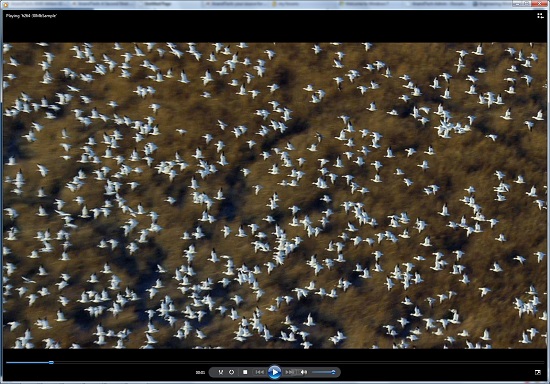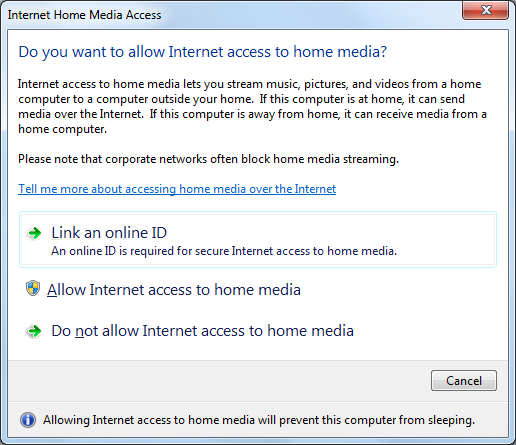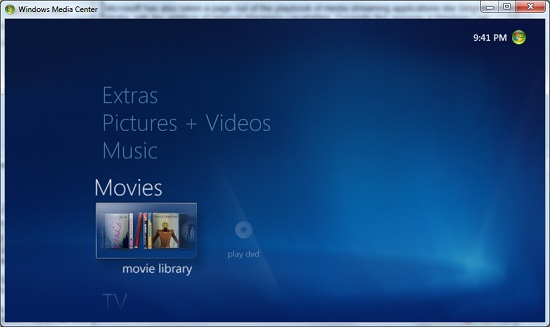Windows 7: Release Candidate 1 Preview
by Ryan Smith and Gary Key on May 5, 2009 11:00 PM EST- Posted in
- Systems
Windows Media : New Codecs, New Looks, New Features
One of the more annoying aspects of setting up a new Windows computer is how little media Windows can play right out of the box. With Vista Home Premium there is support for MPEG-1 and MPEG-2 video, MP3 and AC3 audio, and Windows Media Audio and Video. What has been lacking however is support for more modern video codecs such as MPEG-4 ASP and H.264, along with AAC audio and the container formats these use. This has put Windows well behind most Linux distributions, which include media players capable of playing everything under the sun, and even Mac OS X which includes full H.264/AAC/MP4 support through QuickTime.
With Windows 7 that’s all changing. Windows 7 includes codecs for all the above-mentioned formats and their containers, along with AAC+ (commonly used for streaming audio). This gives Windows 7 the ability to play most common media formats, notably the old standard of Xvid/DivX (MPEG-4 ASP) encoded video inside of an AVI container, and the new standard of H.264 inside of an MP4 container. At this point the only relatively common things Windows 7 can’t read are Matroska containers (which usually contain H.264 video and AC3 audio), DivX3 video, and anything OGG (sorry guys).
The new decoders are available as DirectShow, DirectX Media Object, and Media Foundation codecs, allowing new and old programs alike to access them. This includes both Microsoft applications like Windows Media Center, and 3rd party applications like Media Player Classic Home Cinema. Oh, and did we mention that the MPEG-2 and H.264 decoders are multi-threaded and DXVA accelerated?

Windows Media Player playing a 30Mb H.264 clip entirely in software without breaking a sweat
In our informal testing thus far, once we installed a Matroska splitter we have been unable to find anything that Windows Media Player can’t play. It even manages to play newer QuickTime MOV files, as a result of the MP4 container being based off of the MOV container. The performance of the codecs looks good too. Since the H.264 codec is multi-threaded, it had no issue playing back our 30Mb 1080P test clip even without DXVA acceleration - this clip tends to kill most software codecs. For MPEG-4 ASP, we need to investigate the quality a bit more. It's looking like the Microsoft codecs don't have any post-processing features, which wouldn't surprise us but would put it behind DivX/Xvid in quality.
This brings us to Windows Media Player, which is up to version 12 as of Windows 7. There are few GUI changes to speak of, but the same cannot be said for features. With the aforementioned new codecs, WMP gains the ability to read more shared libraries than just WMP’s; in particular iTunes libraries are now supported, with the exception of songs protected with FairPlay DRM.
Microsoft has also taken a page out of the playbook of media streaming applications like Simplify Media, with the addition of internet streaming capabilities. Currently this requires a Windows Live ID for authentication/security purposes, and only WMP12 works as a client. We know that Windows 7 includes some basic audio/video transcoding features as part of the Media Foundation, and presumably WMP12 is using these features to serve up media. We haven’t had a chance to test this specific feature yet, so we’ll have to get back to it with the final version of Windows 7.

WMP Internet Streaming Configuration
Meanwhile Windows Media Center (7MC), Microsoft’s 10ft UI for HTPC use, has received a much bigger overhaul for Windows 7. The GUI has been given a minor reworking (it’s best described as more Zune-like) but it’s the guts that make all the difference. With the addition of H.264 support to Windows 7, 7MC is now suitable for TV reception in more environments besides North American cable and OTA TV. We’ve previously mentioned DirecTV as a likely addition in the future, and this would also extend to services like IPTV and Freeview, both of which are starting to use H.264.
ClearQAM support is also officially in for 7MC, which means users of the HDHomeRun and other ClearQAM-capable tuners can now pull in unencrypted cable TV networks and watch them on 7MC.
Finally, as we mentioned previously Microsoft has added some transcode abilities to Windows 7 via the Media Foundation Transcode interface. There’s nothing here that will knock your socks off, but via MFT Windows 7 can encode material into a format suitable for mobile devices – that being H.264 video and AAC audio inside of an MP4 container. With mobile devices being the focus of this feature, it should come as no surprise that the H.264 encoder is fairly limited in scope. It can do Baseline profile at SD resolutions up to 1.5Mbps, which is good enough for mobile devices but is not any kind of competition for x264 or other full-feature H.264 encoders.











121 Comments
View All Comments
thebeastie - Wednesday, May 6, 2009 - link
I guess what would be the most naive is to think that Windows 7 is about anything else but money, I mean they could easily improve Vista to have every feature that Windows 7 has, but they wont.MS has handed out whole new versions of DirectX and just about every other type of similar feature that is in Windows 7 so forth via service packs in the past.
Some how come that is not possible these days? Its just about treating us like complete fools.
B3an - Friday, May 8, 2009 - link
...You do know you're talking to yourself thebeastie??Are you really this stupid or is apple paying you to write this?
SkateNY - Wednesday, May 6, 2009 - link
Microsoft is a company in decline. It's top managers, supporters, fanboys, and investors are all in denial about this.Their most recent OS was and remains an abysmal failure. Their attempt at competing in the MP3 market is a disaster, no matter how many people tell us that they love their Zune. Their "loss leader" in game consoles is just that...a leader in losses.
Want proof? Look at the stock price for the past five years...at least five years.
MSFT investors are desperate. They'll say and do anything to make others believe that the company is doing as well now as they were doing before they were adjudicated by the US Department of Justice as violating the Sherman Anti-trust Law in restraint of trade.
They've lost a great deal of their investments over the past ten years. They're so desperate that they need to tell themselves -- and anyone who will listen -- that this is a great company.
Sorry, but as is true in the rest of the real world, what has Microsoft done for anyone invested in them lately? The soft answer would be "nothing." The truth is that they've damaged their investors through bad judgment, poor management, and malfeasance.
What they've done is move a great deal of their previously loyal customers to Apple and Linux. And a large percentage of them who haven't made that move are looking into it.
It's a sad story. With so many resources, the best they could do was barely maintain their core products...Windows and Office. Not enough. The rest of the tech world is passing them by, and they don't seem to have a clue.
piroroadkill - Thursday, May 7, 2009 - link
Huh?Microsoft aren't going anywhere.
SimpleLance - Wednesday, May 6, 2009 - link
"It's a sad story. With so many resources, the best they could do was barely maintain their core products...Windows and Office. Not enough. The rest of the tech world is passing them by, and they don't seem to have a clue."Who in the tech world is passing them by? Linux? There is nothing in the Linux world that is an innovation. Everything is a just a bad copying of what they see in Windows. Same goes for OSX. Name a technology from Linux or OSX, and you will find that in Windows years ago.
In the mean time, there is a lot of Windows features that neither OSX or Linux has.
BitLocker drive encryption - OSX only has folder encryption. Windows has had that since Windows NT 3.x.
Active Directory - now being copied by Linux
Access Control List - only recently added in OSX. Has been in Windows NT 1.0.
Remote Desktop - no equivalent at all in Linux or OSX. All they have is VNC. VNC started in the Windows world that got implemented in Linux and OSX. That is the worst form of remote desktop (screen scraping). Its like a high school student's home work. With Remote Desktop, Windows users threw away VNC as trash, and Linux/OSX picked it up - they really have nothing else, but junk.
SMB - copied as Samba. Where is AppleTalk now? Apple does not know how to write an OS. They had to take BSD.
DirectX - makes Open GL like a kid's work.
Etc. etc.
Who again is overtaking who?
New in Win7...
BITS Branch Cache (Vista had something called Peer Cache) - serverless P2P.
Support for TRIM command for SSD - now perhaps being added to Linux. Another me too effort. Definitely not in OSX.
Improved (less chatty) SMB - Samba is behind again. Nobody in the Linux world could make a better SMB. MS had to do it.
VHD Booting - Linux folks probably scratching their head now. What is that? they say. How do we copy that?
Plus all the other eye candy that people talk about.
Hgr - Friday, May 29, 2009 - link
"In the mean time, there is a lot of Windows features that neither OSX or Linux has."I am sure of that, but of those you are listing here, many simply do not apply.
"BitLocker drive encryption - OSX only has folder encryption. Windows has had that since Windows NT 3.x."
BitLocker is a trademark of Microsoft, so it will be difficult to find it in non-Microsoft operating systems. If you're looking for drive encryption in Linux, distributions have been supporting this for years.
"Active Directory - now being copied by Linux"
Yes, the Samba folks are quite active in reimplementing AD in Samba 4 - as a means of Windows interoperability. Note that DNS, LDAP and Kerberos, the three most important of the protocols that AD is built upon, have been copied by Microsoft from Unix systems. They have been available for Linux de facto from their inception.
"Remote Desktop - no equivalent at all in Linux or OSX. All they have is VNC. VNC started in the Windows world that got implemented in Linux and OSX. That is the worst form of remote desktop (screen scraping). Its like a high school student's home work. With Remote Desktop, Windows users threw away VNC as trash, and Linux/OSX picked it up - they really have nothing else, but junk."
Just because you don't know better solutions does not mean that there are none. VNC certainly isn't a native Linux remote desktop protocol, much less a universal tool for everyday work (it has not been designed to be one). For years, X11 SSH tunnelling has been available. For those who want a low-latency remote desktop, the NX compression protocol and software suite have been available for quite some time, and many are perfectly happy with it. Linux's NX can compress even Windows RDP even further. ;-)
"DirectX - makes Open GL like a kid's work."
Just because DirectX is good for making games does not make OpenGL "a kid's work". After all, DirectX is more akin to SDL than to OpenGL. OpenGL has clearly a different target audience - it is used to build industrial software. Is it surprising that it's different?
"SMB - copied as Samba. Where is AppleTalk now? Apple does not know how to write an OS. They had to take BSD."
Actually, SMB was not invented "at Microsoft". It is an intellectual child of three companies - IBM, Microsoft, and 3com. Many operating systems have later adopted this protocol. Surprising, again? We want to be able to talk to other systems so we adopt it. In Linux, you can use at least half a dozen networked file systems.
"Improved (less chatty) SMB - Samba is behind again. Nobody in the Linux world could make a better SMB. MS had to do it."
Why hasn't it been less chatty before? :-) Well, of course, Samba is behind, Microsoft is in charge of updating their broken protocols, the Samba team is not going to do this for them. A Linux user simply uses a less chatty (less broken?) protocol.
"Support for TRIM command for SSD - now perhaps being added to Linux. Another me too effort. Definitely not in OSX. "
Linux kernel and its file system modules have been ready for this since half a year ago, according to one of the leading Linux file system developers. And it is no "me too effort", not as long as it is not Microsoft that invented it a started manufacturing the devices. Are you trying to imply that for any hardware feature, there is only one OS allowed to support it without being accused of me-too-ism, and that all other systems that include support later are just copycats? Great, I've mentioned Kerberos. Good to see that MS joined the "I want it too" crowd. :-)
andrihb - Wednesday, May 6, 2009 - link
In your dreams, maybe.strikeback03 - Wednesday, May 6, 2009 - link
Unfortunately, there are plenty of applications that don't run natively in any *nix (Adobe is my problem) so some version of Windows is the only option.coolkev99 - Wednesday, May 6, 2009 - link
I don't buy an OS based on company stock price.C'DaleRider - Wednesday, May 6, 2009 - link
[quote]Look at the stock price for the past five years...at least five years.[/quote]OK...I did....and the stock price 5 years ago was in the $24/share range, as it was 4 years ago, 3 years ago, 2 years ago, last year. In fact, it's been around $24 per share going back almost 10 years ago.....although just after the beginning of 2000 it spiked to $48 per share, but then the dot com bubble burst and every tech stock fell, MS's included. The release of XP did give a bump to roughly $34/share, but again fell back to its "base" of around $24/share.
Sorry, but this is the first fact you are sadly misinformed on.
Then, the investors. Don't think most are crying and desperate at all. MSFT has been paying dividends every quarter, like clockwork. Granted, since Vista's release, it's not been spectacular, but has been fairly consistent.
Consider MSFT's 5 yr. net profit margin, 27.9%, is still well above sector and industry average. The company's low price-to-earnings ratio -- which Oakmark Fund places at less than nine, based on estimates for this year's earnings -- is closer to seven if you exclude the $4 a share in net cash.
Nicely, the stock is also currently sporting a dividend yield of 3%. But one problem is that investors, especially individual investors, put too much focus on growth expectations and too little focus on price.
Here's another tidbit you overlooked in your bashing.....MS had an EPS of $1.87 in '08, its highest EPS pay since '99. And MS's net profit has grown from '04-'08, every year. (FYI...net profits were, from '04-'08: $8.1B, $12.2B, $12.6B, $14B, and $17.6B).
Granted '09 will be "dismal," it's been dismal for everyone. But MS will still show a net profit and is paying nice dividends on its stock.
And as for everyone crying and gnashing teeth about MS, I wonder why Barron's, and every other analyist, puts Microsoft as a strong buy and NOT ONE has MS as a sell of any sort.
And game consoles? MS never planned to turn a profit on each...it IS a loss leader, just like the PS3. The games themselves are the profit center. Always has been like that and probably will always be like that.
So, where's the panic? Where's the problem? MS is still sitting on over $640M in cash reserves.....something a lot of companies can only wish to have.